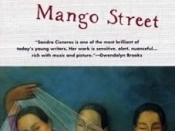The Symbolism of The House on Mango Street
In The House on Mango Street, Sandra Cisneros addresses and develops the
themes of assimilation of the Chicano into American society, stereotypes, and the
treatment of the Chicana within her culture. These themes are brought out through the
experiences of Esperanza, a young Chicana character. The American society has tried to
make the Chicano fir into its culture and make him follow its way of doing things. The
Chicano has also 'voluntarily' tried to assimilate because of the negative attitudes towards
him and his culture. There are several problems with assimilation for the Chicano based
on cultural differences. The main difference is that Latin cultures are more spiritualistic
and the U.S. are more materialistic in nature. Stereotypical images of the Chicano have
developed. These shed a negative light onto this minority group. For instance, many
times the Chicano is portrayed as lazy or evil.
Stereotypes such as these have made it
difficult for Chicano to succeed in this capitalistic society. The Chicana has had an
especially difficult time, because of her status as a minority woman. The old traditional
role in Mexican culture has also served to oppress these women. These themes are
intertwined throughout Cisnero's novel.
One was Cisneros brings out the theme of assimilation in The House on Mango
Street is through the concept of the 'American Dream.' The dream is to own a home. It
is a symbol of success in a materialistic world. Esperanza, the main character, expresses
this desire in 'A House of My Own.' (pg. 108)
Esperanza and her family, like a large portion of the Chicano minority, live in a
barrio. Her family had lived in several other places and had felt the pain of poverty. 'We
had to leave the flat on Loomis quick.


